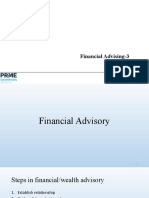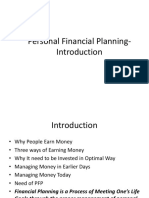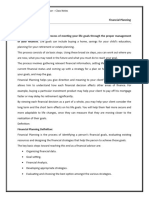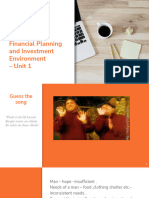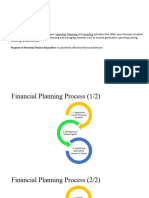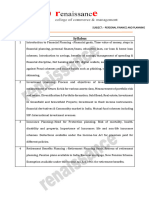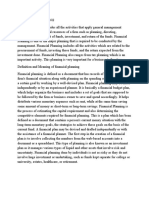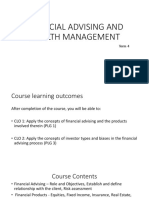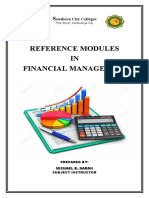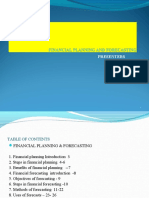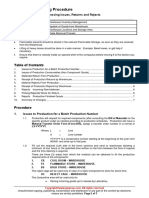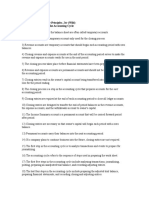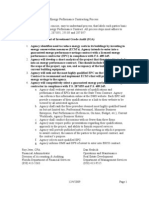Week 1: Financial Planning and the Profession
Financial Decisions Individuals may need to make
o Consumption vs. Savings: Managing cash flow and cultivating a savings habit. How much should I save? Should I contribute to my super? Should I enjoy life today at the expense of tomorrow? Investment: Where do I put my money? Which company should I buy? It is the right time? Are managed funds good or bad? Financing: HECS or pay outright? Pay by credit card or from loan? Cash? Asset protection: What types of insurance should I buy? Life? Car? How much? How will a divorce affect my finance and wealth? Prenuptial agreements. Estate planning: Wills; what to leave behind for your future generation.
Reasons why individuals need a Financial Advisor
o o o o o Specialisation of labour and capital. Up-to-date relevant and reliable information. Technical expertise greater understanding of financial concepts and market info. More rational (less emotional) actions. Financial advisors must be aware of the business cycle when suggesting options and solutions to clients: Recession high unemployment low economic growth. Recovery unemployment begins to fall, economic growth begins to rise. Boom expansion high employment and economic growth increase in inflationary conditions. Contraction economic growth starts to slow, level of unemployment begin to rise, falling retail sale.
Steps in the Financial Planning Process
o Financial planning is a process whereby a persons total position, both financial (quantitative data) and non-financial (qualitative data) is examined, and a set of actions or plan is put in place which once implemented, will assist in meeting the persons ultimate goals and objectives. 1) Data gathering. 2) Analysis of goals and objectives. 3) Strategy formulation and identify problems that may exist. 4) Preparation of the Statement of Advice (SOA). 5) Implementation of the plan. 6) Review and monitor.
�Development of Financial Planning Industry
o o o o Before the 1990s, there were life insurance brokers and agents. The aging population, superannuation schemes and deregulation of the financial market encouraged the growth of the financial planning industry. Deregulation also saw the rise of the independent and commercial banks. Insurance brokers evolved into a mixture of agents/brokers and professionals specialising in financial planning advisory.
How to select a financial planner
o There are no definite ways, but ask these questions: How long have you been giving advice? What are your qualifications? Do you own part of your advisory firm? Minimise conflict of interest. What type of clients do you specialise in? What resources does your company have in terms of investment research? Do you give independent advice? Written advice? How do you charge? Fee or commission? Is it an ongoing service?
Regulatory Framework
o Australian Security Investment Commission (ASIC): Key regulator of the financial advisory industry. Administers Commonwealth legislations such as the corporations Act 2001. Australian Prudential Regulatory Authority (APRA): Ensure the company/sector has adequate risk management procedures. Ensure the risk management procedures are ran in a safe and sustainable manner. Australian Taxation Office (ATO) Australian Consumer & Competition Commission (ACCC): Consumer and competition protection. Fair trading.
o o
�Week 2: Budgeting & Financial Planning
Steps in the Financial Planning Process
1. Collect and assess the financial data of the client
o o o Clients will be a diverse group, with different backgrounds, experiences, resources, concerns and goals. Each factor will present a unique challenge to the financial advisor. It is both a legal requirement and common sense for financial advisor to be aware of the clients specific circumstances. Client information in 3 categories: Quantitative data: Financial data: clients individual income, expenditure statement and balance sheet. Personal information such as age and investment horizons. Financial objectives: the level of future income required for the client to maintain their desired lifestyle.
In-depth Information - Financial Statements:
Financial statements define current financial conditions and enable the tracking of change in the clients financial position over time. Balance sheet: summarises the financial position at a certain point in time. o Total assets = total liabilities + net worth o Assets: Liquid assets: cash, savings. Investments: shares, bonds. Real estate: immovable property such as land, house. Personal property: movable property such as cars, clothes. o Liabilities: Current liabilities: household bills. Long-term liabilities: mortgages, loans. o Net worth amount of actual stake or equity an individual has in owned assets. Income and expenditure statements: captures the various financial activities that have occurred over time (usually 1 year): o Income o Expenditure o Cash surplus/deficit. Reviewing Financial Performance o Balance sheet ratios: Solvency ratio: Total net worth Total assets How much protection you have against insolvency. How much the value of your assets can decrease before becoming insolvent. The higher the better.
Liquidity ratio: ___Liquid Assets ___ Total current liabilities How long one could continue to pay current liabilities with existing liquid assets in the event of income loss. should be between 25-30% Income and expenditure ratios: Savings ratio: ___Cash surplus____ Income after taxes Shows the proportion of income that is saved. Average is 5% for the average family. Debt service ratio: ___Total monthly loan payments___ Monthly gross (before tax) income Excludes current liabilities. Ratio shows the ability to meet debt obligations. Should be under 30%
__________________________________________________________________________________ Qualitative data: Goals and objectives including short, medium and long term. Issues and concerns of the client e.g. young family concerns about buying their first home. Preconception as to the clients needs in retirement. Assessed data: Risk tolerance assessment Financial literacy assessment It is essential that financial planners clarify the data gathered with the clients to ensure the plan will be correct. During data collection, the financial advisor must determine the clients lifecycle: Saving vs. consumption: Tends to apply to younger people. Just finished their education and looking for a new job, vacation, etc. Early family formation: Young families May have concerns on childcare fees, school fees, insurance, etc. Wealth accumulation stage: People tend to earn a higher salary. Mortgage is not taking much of income. Have a balanced life of work and leisure. Have the financial capability to invest in the share market and property market. Approaching retirement: Early 50 65 years of age. Have concerns about wanting to maximise their retirement savings. Reduced risk as inflow of income is going to be limited. Post-retirement: Manage income so it will last their lifetime. Have a comfortable retirement.
o o
�2. Determine the Objectives and Goals of the Client
o Short term goals: Set each year and should be consistent with the established long term goals. Short term sacrifices may be necessary to provide for a comfortable future. Long term goals: Wants and desires for the next 2-5 years out to the next 30-40 years. Many long term goals change over time. Long term goals provide a general direction for the long haul Financial advisors have to work with clients to determine if the goals are attainable given the clients financial position.
3. Identify any Personal Issues Which May Get In the Way of Them Meeting Their Goals
o o o Clients do not understand the implications of their goals, hence may have false expectations. Discussing trade-offs with clients will ensure they understand the sacrifice they need to make if they wish to achieve their goals. Financial advisors must also be aware of the Clients current situation and issues, which may include: Lack of personal and property insurance cover when loss occurs, they will have no way of meeting the financial consequences. Tension between providing private education for children vs paying mortgage vs saving for retirement not very realistic for young families. Clients may have too much personal debt from paying high interest rate on personal loans and credit cards. Financial advisors must resolve any troublesome situations and issues before going on to make recommendations regarding investment.
4. The Preparation of a Written Plan (SOA)
o Covering letter personalised Professional but not necessarily formal language. Clear and concise and readily understandable. Written on letterhead with contact information. Dated. Include the name of the licensee and its license number & ABN. Be signed by the financial advisor stating they are an Authorised Representative of the licensed dealer. Letter should invite the client to contact the financial advisor should there be any information that is incorrect or if they just want to ask something. Must warn the client that decisions regarding implementation of the SOA must be made within 30 days. Should get the client to understand the need for annual reviews. Cover page: Should state that the document is a SOA. The name of the recipient. The date that the plan is to become effective. Name and contact details of the financial advisor who provided the plan. Name and contact details of the licensee who authorised the SOA. A statement that the plan is private and confidential.
A warning box that reminds the client that it is an important document and it should be read carefully and in full, to contact the financial advisor if they wish, and any information required about the cooling off period (period where we allow clients to choose if they want to go ahead with the plan. The client is able to get out of the contractual agreement without any financial penalty. Executive summary: No more than 2 pages. Bullet form. Include key personal detail of the client shows client that the advisor has understood their position. Summary of clients goals and objectives. State each main recommendation: Who is to act? How much money is involved? Where the money is to come from? Provide a warning in relation to projections. Expected outcomes from each investment portfolio Confirm likely goal achievements. Provide warning because the projections are based on assumptions hence there is a degree of uncertainty. Table of Contents Keep things simple Outline the structure of the plan. Ensure all pages are numbered. Keep to major headings and do not over complicate. The body of the SOA A basis for advice: A clear and concise restatement of all relevant client information. An estimated cash flow for the current financial year that identifies any excess savings capacity which the client can use to fund goal achievement. A chart showing the clients assets and liabilities. - Ensure client has an emergency fund set aside for unexpected events. An analysis of the clients investments. A full discussion of the clients personal risk tolerance. - Asset allocation preference (risk averse = treasury bond; risk lover = shares) - A list/discussion of all personal and financial assumptions. - A discussion of the clients concerns and issues that may impeded on goal achievement. - A source and use of fund chart that will clarify the clients situation and the funds available for investing. Statement of strategy: How the recommendations are to be done. Strategy must be flexible to deal with the likely changes of circumstances that clients will experience. Risk management and insurance cover: Essential because unforseen events may cause financial loss. A full review must be completed discussing strategies to deal with deaths, illness, etc.
Estate planning: Important to point out to clients the importance of having a written structure to back up their wishes on the transference of their wealth. Advisor should discuss these matters with the client and prepare them for a visit to an appropriate legal profession. Taxation: Advisors should recommend tax-effective investment products or structures consistent with the clients ability to accept legislative risk. Advisor my advice client that they are not a tax advisor. Investment recommendations: Be generic. Should move from the most tax-effective (superannuation) to the least (often managed funds). Each recommendation must be referred to the clients risk tolerance asset allocation as well as refer to the specific goal achievement. Superannuation, retirement planning and social security issues: Must consider the best use of superannuation balances and possible social security benefits. Consider the options of being able to make additional contributions to superannuation. Specific product recommendation: After the generic discussion on strategies, specific products must be recommended. Clearly identify the characteristics of the product and all the product provider and show how the product matches the clients risk profile and financial needs. Product recommendations should be fully justified and a risk-benefit analysis completed. Post implementation cash flow: Client needs to see they can afford to implement the recommendations. A post implementation cash flow will show the client they will still have enough money to manage daily living requirements. Include indicative costs for additional insurance and the cost of legal work and periodic reviews. Cost benefit discussion: Show client that the benefits outweigh the costs of implementation and ongoing management. Fees and commissions: The advisor must disclose: - Any remuneration including fees, commissions or any other pecuniary/non-pecuniary interests the financial advisor may have in any of the products recommended. - Any benefits the financial advisor and 3rd party receives. - Any other costs to be borne by the client. Disclosure of capacity: The financial advisor reminds the client what areas of financial advice they provide and the type of products and services they can offer. Disclaimers:
Act as a warning as to how the information provided in the plan can be used and that it is specific to the client and not for general use. Limit potential legal action by making the client aware of the scope of the advice. Monitor and review: Needs to be personalised for the specific client. Client needs to see why it is important for their goal achievement to undertake annual reviews. Client need to know what the annual process will be. Costs of annual reviews must be disclosed. Implementation schedule: Detailed statement of all actions. The more detailed, the more likely the plan will go smoothly. Should include who, what, when, where, how, costs, etc. Authority to proceed: A formal business letter provided by the financial advisor for the client to sign. Letter is to confirm everything in the SOA is correct and that the client agrees with everything. Appendices: Should be strictly limited. Contain the financial worksheets that back up the recommendations in the SOA. Do not place educational materials in here as it will only confuse the client.
5. Implement the Agreed plan
o o Financial advisor should monitor the implementation process. Ensure each step is completed timely and accurately.
6. Review the Plan
o o o o o o Periodic scheduled reviews. Allows the changing nature of the clients circumstances to be implemented. Adequacy of the clients insurance cover to be reviewed. Client should be supplied with an updated value of the investment portfolio and be compared with the previous reviews. If additional action needs to be taken, a new SOA needs to be issued. Product replacement forms to be filled if recommended to change products what benefits are being sacrificed for new benefits.
�Week 3: Asset Allocation
Key Asset Classes & Instruments
o Short term vehicles: Money market instruments such as cash, savings accounts, bank accepted bills, CDs, treasury notes. Carry little or no risk. Very liquid. 3-6 months of after tax income should be held in short-term vehicles to meet unexpected needs or to take advantage of attractive investments opportunities. Shares: Equity investments that represent ownership in a corporation. Return on shares come from dividends (periodic payments, usually semi-annually, made by corporations to its shareholders) and capital gains (result from selling the share at a price above that for which it was originally purchased.) Measurement of share performance: Book value: assets liabilities preference shares Net profit margin: _NPAT_ Revenue Return on equity: _NPAT_ Equity Earnings per share: NPAT preference dividends Number of ordinary shares Price earnings ratio: __Price per share__ Earnings per share Constant dividend model: P = D0 r Constant growth: P = D0(1+g) = _D1_ r-g r-g Fixed income securities: Some offer contractually guaranteed returns while others have specified but not guaranteed returns. Bonds: Long term debt instruments of corporations and governments. Holder has a contractual right to receive fixed interest return (coupon interest) plus the return of bonds face value at maturity. Preference shares: Have a stated dividend rate. No maturity date. May also provide capital gains. Convertible securities: Has a feature allowing the investor to convert it into a specific number of shares. Has fixed income benefits while offering the price growth potential of shares when they have been converted. Derivative securities: Derive their value from the value of an underlying security or asset. High level of risk, high level of return.
Options: America = exercise any time; European = only exercise at maturity. - Futures: legally binding obligations stipulating that the buys of the contracts will take delivery and the buyers of the contracts will take delivery of a specified commodity/financial instrument at some specified date in the future at a price agreed on the time the contract is sold. Managed funds: An institution that raises money from fund investors and invests in and professionally manages a diversified portfolio of securities. Investors in the fund own an interest in the funds portfolio. Includes unit trusts, cash trusts, superannuation funds, etc. Real estate: Residential home, vacant land, warehouses, office and apartment buildings. Returns in the form of rental income, tax deductions and capital gain. Tangibles: Investment assets other than real estate such as gold, other precious metals, collectibles, etc.
Risk and Return
o Sources of risk: Exchange rate risk: when investing in foreign markets. Business risk: a degree of uncertainty with a firms earning. Financial risk: amount of debt a firm has determines the risk of default. Purchasing power risk: purchasing power may decline. Interest rate risk: fixed income securities have inverse effect. Liquidity risk: risk of not being able to liquidate on investment conveniently and at a reasonable price. Tax risk: unfavourable changes in tax laws. Market risk: market factors such as political, economic, and social events, or by changes in investors tastes and preference. Event risk: when something happens that is sudden and has financial impact. Components of risk: Total risk = non-diversifiable risk (systematic) + diversifiable risk (unsystematic) Returns from investing: Current income: dividends from shares, interest received on bonds, rent received from real estate. Capital gains: selling the investment for more than originally purchased. Holding period return: Total return from holding an investment for a specified period of time. HPR = current income during period + capital gain/loss Beginning of investment value Internal rate of return: HPR fails to consider the time value of money whereas IRR does. Risk return trade-off High rate of return = high level of risk Low level of risk low rate of return.
o o
o o
�Asset Allocation and Risk Tolerance
o The method of distributing a clients wealth among different asset classes such as: Cash and fixed interest. Direct and indirect property. Domestic equities. International equities. Risk tolerance: a measure of an individuals willingness to accept a level of investment risk in exchange for higher potential returns. Risk profiles: Defensive investors: wish to remove any type of risk and want a guarantee security. 100% defensive assets (cash and fixed interests) Conservative investors: willing to accept a measured amount of risk. Ensure investment retains purchasing power. 80% defensive assets, 20% growth assets (cash, fixed interest and property) Moderately conservative investors: more comfortable with determinable levels of risk and willing to accept modest loss. 60% defensive assets, 40% growth assets. Balanced investors: seek higher level of growth but wish to have a balance in defensive assets to manage risk. 40% defensive assets, 60% growth assets. Assertive investors: more experience in investing and willing to accept higher level of price volatility when seeking higher returns. 20% defensive assets, 80% growth assets. Aggressive investors: very experienced in investment markets and are willing to take high level of risk in short term when seeking high levels of long term returns. 100% growth assets. Asset allocation strategies: Strategic asset allocation (SAA): periodically rebalancing the portfolio in order to maintain a long term goal for asset allocation. Tactical asset allocation (TAA): an active strategy that rebalances the portfolio to take advantage of market pricing anomalies or during strong market sectors. Portfolio will return to the original strategic mix when the short-term profits are achieved. Sector rotation strategy: movement of money from one industry sector to another industry that is performing better due to economic cycles.
o o
Stock Classifications
o Blue chip shares: Issued by large, well established companies. High yielding shares. Very popular, hence are highly priced. E.g. commonwealth bank shares. Value shares: Pay above average dividends. Relatively safe and shows capital appreciation. Many blue chip shares are also classed as value shares. Growth shares:
Used by companies that has experienced and is expected to continue experiencing high rates of growth. Pay low/no dividends but retain their earnings. Speculative shares: No record of success, but offer potential for strong price growth. Higher risk due to stock price volatility. E.g. dot.com companies in 2000. Cyclical shares: Companies stock prices move in the same direction as the business cycle. E.g. Bluescope and James Hardice. Defensive shares: Companies stock prices remain stable during economic downturns. Typically shares in mining, resource companies, as well as food/health product companies. E.g. Boral, BHP, Woolworths.
Efficient Market Hypothesis
o o o o Efficient market = all information is reflected in market price and investors cannot make any abnormal returns. Weak form efficient: prices reflect historical prices. Semi-strong price reflect all publicly available information + weak form. Strong: prices reflect all public and private information + weak form.
�Week 4: Securities Transactions and Borrowings
Distinguish Between
o Money market vs. capital market: Money market: contains securities that are short term. E.g. bank accepted bills, cash deposits, p-notes. Capital market: contains medium to long term securities. Within the capital market, there is also equity market, corporate debt market, government debt market, FX market and derivative market. Primary vs. secondary market: Primary market: where new securities are sold to investors. e.g. government issuing bonds; company raising capital by issuing shares IPOs Secondary market: where securities are traded after they have been issued. Organised securities exchange vs. over-the-counter markets: Organised securities exchange: centralised institutions for the trading of securities that are already on issue. Auction market where prices are determined. ASX, SFE, etc. OTC market: information market where traders use advanced telecommunication to trade. OTC link buyer or sellers with a dealer. Market makers (dealers) vs. brokers: Market makers: they buy sets of securities to then sell to investors. Buy cheap, and sell for more (bid-ask spread) Car dealer concept. Brokers: act as an agent to investor to buy/sell shares for them. Includes full serviced and discount brokers.
Regulating Markets
o o o o Australian Securities and Investment Commission (ASIC): administers the Commonwealth Corporation Act (2001) Australian Competition and Consumer Commission (ACCC): Trades Practises Act 1974 protects competition fair for consumers. ASX: monitor market activity for any irregularities and take action if have to. They also enforce market and listing rules transparent information and continuous disclosure. SFE: ASIC and SFE regulates the futures and options market. Ensure brokers are licensed; client advisors are registered, etc.
Order Placement Methods
o Market order: Buy or sell securities at the best price available. Quickest way to have orders filled, because market orders are executed as soon as they are received by the dealer. No execution risk, but incurs liquidity costs. Limit order:
Buy at or below a specified price OR sell at or above a specified price. This method may get you a better price, but may not execute. Stop-loss order: Sell when price reaches or drops below a specified level. This is a derivative trading method for capital protection and risk control. Order will execute at the specified price, even if future prices are more favourable.
Growth of Debt in Australia
o o o Increase competition from lenders introduction of new product and selling strategies. Critics are concerned by the increasing use of credit/debt and the finance industry offering even more credit. Before the financial crisis, banks viewed growth in home lending as sustainable, hence allow borrowings. When the economy began to downturn, many borrowers couldnt pay off their mortgage and hence the growth of debt in Australia. Retailers provide 48 month interest free, no deposits schemes that also increased debt within Australia. No mention of interest rates after the interest free period. No mention of any monthly repayments. Retailers hope customers are unable to pay the full amount by the end so that they can charge them with high interest rates. Credit cards and rewards points program contributed to the growth of debt. The more you spend, the more points you earn customers will then incur a higher balance, hence additional/higher interest charges. Lending companies that promote no credit checks and immediate approvals fail to mention higher interest rates. Another contributor.
Types of Credit
o Consumption financing Credit cards: Allow immediate purchase without having to carry cash. Cheaper to use credit card if low balance is maintained or full balance is paid each month. Allow consumers to take advantage of special sales. Personal loans: Loans to purchase personal items cars Can be secured, short or longer term (5yrs) Leasing financing: Lender retains title on the leased item. Payments are made up of interest and partial payments of the principal Asset financing: Home loans: require repayment of principal and interest over 10-30 years. Fixed/variable rates Line of credit accounts Reverse mortgages Balloon payments Bridging loans: fund the purchase of one asset, while another asset is being sold.
�Gearing and Margin Trading
o Gearing: when money is borrows for investment purposes. Advantages: more money to be used for investment and the interest costs are tax deductible. Disadvantages: debt must be repaid; high potential losses as for gearing to be successful, all of the borrowed money must be invested in growth assets; additional costs must be paid when borrowing such as fees. Margin trading: borrowing money to buy shares. Advantages: more money to be used for shares; profit is magnified when they are made. Disadvantages: losses are magnified; and there are additional costs involved such as brokerage and lender fees. When gearing/margin trading is recommended to the client, the advisor must consider: Market conditions Repayment capability of the client. Investment horizons should be long. Job stability must be stable. Risk tolerance has to be high. Bankruptcy The risk when individuals liabilities exceed their assets and their income can no longer sustain payment of their debts. Excess borrowing can lead to bankruptcy. Bankruptcy Act 1966 (Cth) seeks to do two things: i) Have the debt repaid. ii) Assist the bankrupt to restructure their life so that they do not become bankrupt again.

